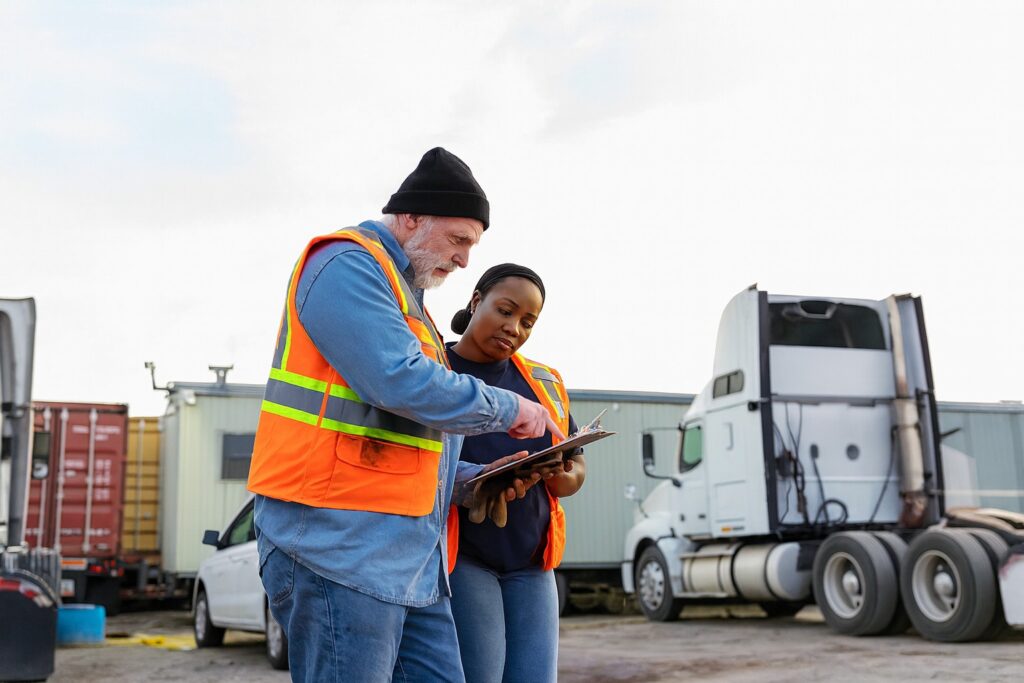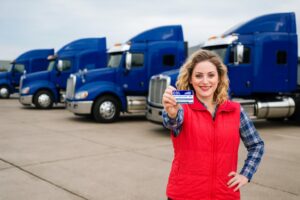The trucking industry is a massive part of the United States economy. The American Trucking Associations claims that the sector moves about 72% of all freight in the country. There are over 3.5 million truck drivers on the road.
If you want to start your own trucking business, being an owner-operator truck driver can offer you more freedom. It can also provide higher pay and a way to become an entrepreneur.
This guide explains each step and shares essential facts and figures. It walks you through the process. You will learn how to get your commercial driver’s license.
You will learn how to set up your authority. You will also learn how to manage compliance with the Federal Motor Carrier Safety Administration.
What Does an Owner Operator Truck Driver Do?
Owner operator truck drivers are not company drivers. They own or lease their commercial vehicle and contract their services out to motor carriers or directly to shippers.
As an owner operator, you control your routes, loads, and schedule. You manage your trucking business, handle your expenses, and make big decisions. Unlike company drivers, owner operators are self-employed and must follow federal motor carrier safety regulations.
Let’s check the steps to becoming an owner-operator truck driver.
Step 1: Understand the Requirements
Age, Education, and Entry Level Experience
First, you must be at least 21 to drive a commercial vehicle across state lines. Most trucking companies and motor carriers require at least a high school diploma or GED, but the fundamental requirement is a commercial driver’s license (CDL).
Get Your Commercial Driver’s License (CDL)
Your first big step is earning a CDL. You need this license to operate large trucks and commercial vehicles. Training programs at community colleges or specialized driving schools prepare you for the written tests, skills exam, and the Department of Transportation (DOT) physical. According to the FMCSA (Federal Motor Carrier Safety Administration), you must also pass a drug test before you get your CDL.
Gain Experience as a Company Driver
Many owner operators start their careers as company drivers. Working for a trucking company gives you the entry-level experience to understand life on the road, manage freight, and meet federal and state regulations. Most motor carriers and insurance companies want you to have at least two years of driving experience before going independent.
Step 2: Build a Financial Foundation
Calculate Your Costs
Launching a trucking business as an owner operator requires careful planning. You must invest in your commercial vehicle, set up insurance, and prepare for ongoing costs.
- Truck Purchase or Lease: A new truck may cost between $120,000 and $200,000. A used truck may cost $50,000 to $100,000.
- Insurance: Plan for $8,000 to $16,000 annually for primary liability, cargo, and physical damage coverage.
- Startup Expenses: Permit fees, registration, and business setup can cost another $2,000 to $4,000.
- Maintenance Fund: Set aside $5,000 to $10,000 to cover repairs and breakdowns.
- Fuel: In 2024, the average diesel price in the U.S. hovered around $3.90 per gallon.
According to the Owner-Operator Independent Drivers Association, the average owner operator spends about $1.60 per mile on expenses, which includes fuel, maintenance, and insurance.
Step 3: Choose and Acquire Your Truck
Research Truck Options
Consider the types of loads you plan to haul, including general freight, refrigerated goods, hazardous materials, or oversized items. The type of truck you choose—dry van, reefer, flatbed, or tanker—should fit your long-term goals.
Buy or Lease?
Buying a truck gives you full ownership and long-term value, but requires more upfront cash. Leasing lets you start with less money and often includes maintenance, but you do not own the truck at the end of your term.
Inspect any used truck for mileage, maintenance records, and signs of wear. Look for warranties and ask about fuel efficiency.
Step 4: Register Your Business and Get Legal
Set Up Your Business
Register your trucking business as a sole proprietorship, LLC, or corporation. Choose a business name and set up a business bank account.
Apply for a USDOT Number
All owner operators need a USDOT number from the Department of Transportation. This number identifies your business and tracks safety compliance.
Apply for Your Motor Carrier (MC) Number
If you want to haul freight for hire in interstate commerce, you must get a Motor Carrier (MC) number from the Federal Motor Carrier Safety Administration. This process includes background checks and proof of insurance.
Enroll in the International Fuel Tax Agreement (IFTA)
Owner operators who travel between states must participate in the International Fuel Tax Agreement (IFTA). This agreement simplifies reporting of fuel use taxes to each state you operate in.
Obtain Other Permits and Credentials
You may need additional permits and registrations, such as:
- Unified Carrier Registration (UCR)
- Heavy Vehicle Use Tax (HVUT)
- Hazardous Materials Endorsement: If you plan to transport hazardous materials, take the TSA background check and pass the written test.
- Drug and Alcohol Consortium Enrollment: Stay compliant with DOT rules.
Step 5: Set Up Insurance and Safety Programs
Required Insurance
FMCSA requires that owner operators carry minimum amounts of liability and cargo insurance. Many shippers want at least $1 million in liability and $100,000 in cargo insurance. Shop around for quotes and make sure you understand what is covered.
Carrier Safety Administration Compliance
Follow all rules set by the Federal Motor Carrier Safety Administration. Use Electronic Logging Devices (ELDs) to track hours, keep maintenance logs, and prepare for random DOT inspections.
Step 6: Find Loads and Build Your Network
How Do Owner Operators Find Loads?
The success of your trucking business depends on finding good loads. Most owner operators use several methods:
- Load Boards: Online platforms like DAT, Truckstop.com, and 123Loadboard post thousands of loads daily.
- Freight Brokers: These intermediaries connect motor carriers and shippers with owner operators for a fee.
- Direct Contracts: Building relationships with shippers can bring regular, high-paying work.
- Dispatch Services: For a small percentage of your revenue, dispatchers find loads and handle paperwork.
According to DAT Freight & Analytics, over 900,000 loads appear on national boards every day.
Step 7: Manage Your Trucking Business
Handle Your Books
Use accounting software or hire a trucking-focused accountant to track expenses, revenue, taxes, and IFTA filings. Good records help you stay compliant and increase profits.
Schedule Maintenance
Preventive maintenance is cheaper than emergency repairs. Track your truck’s mileage and perform regular oil changes, tire checks, and safety inspections.
Safety and Compliance
The FMCSA and DOT can audit your records at any time. Always keep your logbooks accurate, follow rest and driving time rules, and respond quickly to requests from the carrier safety administration.
Step 8: Stay Educated and Adapt
Keep Up With Industry Changes
The trucking industry keeps evolving. New rules, technology, and equipment appear every year. Subscribe to trucking publications, attend industry events, and take extra training to stay ahead.
Hazardous Materials and Special Endorsements
If you want to haul hazardous materials or oversized loads, invest in special endorsements. Hazardous materials require extra background checks, training, and testing, but can lead to higher pay and more job options.
Owner Operator Truck Driver: Facts and Figures
- Number of U.S. Owner Operators (2023): About 350,000
- Annual Gross Revenue: $180,000 to $220,000
- Annual Net Income: $45,000 to $80,000
- Average Startup Costs: $40,000–$60,000 for most first-time owner operators
- Average Owner Operator Age: 45 years old
- Average CDL Training Time: 7–12 weeks
Source: American Trucking Associations, OOIDA, FMCSA

Common Questions
Are owner operators considered employees?
No. Owner operators are self-employed and must manage their own business, taxes, and compliance.
What is the carrier safety administration (FMCSA)?
The Federal Motor Carrier Safety Administration makes safety rules that apply to all motor carriers and owner-operators in the United States.
Do I need a CDL to become an owner operator?
Yes, you must hold a valid commercial driver’s license.
How do I get a USDOT number and MC number?
Apply for your USDOT and MC numbers through the FMCSA Unified Registration System.
What is IFTA, and why does it matter?
IFTA stands for International Fuel Tax Agreement. It allows owner operators to file a single fuel tax report for all their states, making tax compliance easier.
Conclusion
Becoming an owner operator truck driver in 2025 takes planning, training, and business skill. You must earn your CDL, gain industry experience, choose the right truck, register your business, and stay compliant with all federal and state regulations. You will manage your finances, build relationships, and keep your equipment in top shape.
With over 350,000 owner operators already on the road, this career offers both independence and the chance for higher earnings. Whether you haul general freight, hazardous materials, or specialty loads, owner operator employment can help you build the trucking business you want—on your own terms.
Take your first step today. Study for your commercial driver’s license, research trucks, and build a strong foundation for your future as an owner operator.







